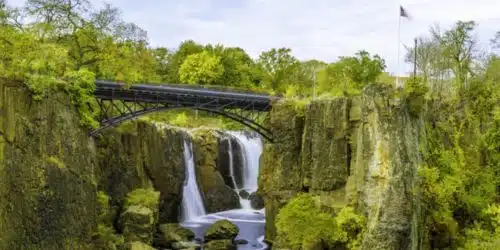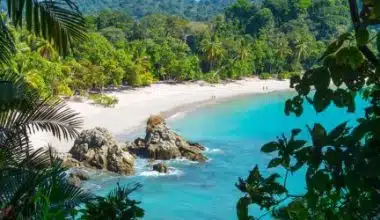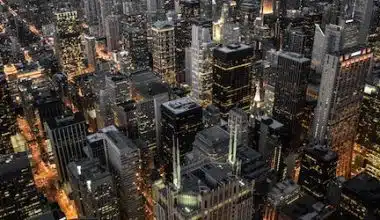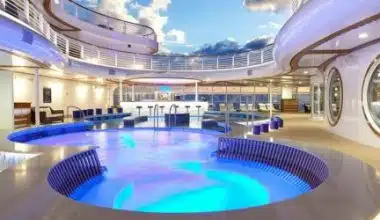Waterfalls in New Jersey offer diverse natural beauty and recreational opportunities, with varying heights and surroundings. In such times, visitors must follow park regulations, stay on designated trails, and avoid activities that could harm the environment or compromise safety. In this article, 10 amazing waterfalls in New Jersey were listed with favorable features and guidelines to have in mind for a wonderful experience.
List of Notable Waterfalls In New Jersey
New Jersey is home to several beautiful waterfalls that attract visitors and hikers.
Some of the notable waterfalls in New Jersey include:
#1. Great Falls of the Passaic River
Located in Paterson, Great Falls is one of the most impressive waterfalls in New Jersey. It is part of the Paterson Great Falls National Historical Park and offers stunning views and hiking opportunities.
#2. Buttermilk Falls
Situated in the Delaware Water Gap National Recreation Area, Buttermilk Falls is a popular destination for nature enthusiasts. It’s a relatively easy hike to reach the falls, making it accessible to a wide range of visitors.
#3. Chikahoki Falls
Found in the Palisades Interstate Park in Alpine, New Jersey, Chikahoki Falls is a hidden gem. The hike to the falls can be challenging, but the scenery and tranquility make it worth the effort.
#4. Hemlock Falls
Located in South Mountain Reservation near Millburn, Hemlock Falls is a serene spot surrounded by lush greenery. The waterfall is easily accessible via well-marked trails.
#5. Boonton Falls
Situated in Grace Lord Park in Boonton, these falls are a picturesque sight, especially after heavy rainfall. The park also offers scenic walking trails.
#6. Tillman Ravine Falls
This waterfall is within the Delaware Water Gap National Recreation Area and requires a moderate hike to reach. The journey to the falls is as rewarding as the waterfall itself.
#7. Ramapo Valley County Reservation Waterfalls
This reservation in Mahwah is home to several waterfalls, including Van Slyke Castle Falls and Twin Falls. Hiking through the area allows you to discover the natural beauty of the region.
#8. Tillman’s Ravine Falls
Located in Stokes State Forest, this waterfall offers a picturesque sight amidst the forested landscape.
#9. Greenbrook Falls
Situated in Greenbrook Sanctuary in Tenafly, this serene waterfall is a lovely natural spot to explore.
#10. Van Campens Glen
This serene waterfall is located in the Delaware Water Gap National Recreation Area and offers a peaceful setting for hikers and nature lovers.
Features of Waterfalls In New Jersey
Waterfalls in New Jersey come in various sizes and shapes, offering unique features and natural beauty.
Here are some common features of waterfalls found in New Jersey:
#1. Height
While not as tall as some famous waterfalls in other regions, New Jersey’s waterfalls can range from a few feet to over 70 feet in height. The height of the falls adds to their visual appeal and the intensity of the cascades.
#2. Scenic Surroundings
Many waterfalls in New Jersey are nestled in picturesque settings, surrounded by lush greenery, rocky landscapes, and serene forests. These natural surroundings create a tranquil and captivating atmosphere for visitors.
#3. Hiking Opportunities
Several waterfalls in New Jersey require a short hike to reach, offering opportunities for outdoor enthusiasts to explore nature and enjoy scenic trails.
#4. Seasonal Changes
Some waterfalls in New Jersey may experience fluctuations in flow and appearance based on seasonal rainfall and weather conditions. Visiting during different times of the year can offer varying views and experiences.
#5. Recreational Activities
Waterfalls in New Jersey are often located within or near parks, providing visitors with recreational activities such as hiking, picnicking, and birdwatching.
#6. Historical Significance
Some waterfalls in New Jersey have played a role in the state’s industrial history. The Great Falls of the Passaic River were utilized for its hydropower during the early industrial era.
#7. Accessibility
Many of New Jersey’s waterfalls are easily accessible, making them suitable for families, casual visitors, and individuals with various mobility levels.
Steps In Planning For A Visit To the Waterfall in New Jersey
Visiting a waterfall in New Jersey can be a rewarding and enjoyable experience.
Here are the steps to help you plan your visit:
#1. Research Waterfalls
Start by researching the various waterfalls in New Jersey. Look for information on their locations, accessibility, hiking trails, and any specific regulations or guidelines for visitors.
#2. Choose a Destination
Once you have a list of waterfalls you’re interested in, choose one that suits your preferences and travel distance. Consider factors like the level of hiking difficulty, the surrounding scenery, and available amenities.
#3. Check Accessibility
Confirm that the waterfall is accessible to the public and whether there are any specific opening hours or seasonal restrictions. Some waterfalls may have limited access during certain times of the year.
#4. Plan Your Route
Use GPS or maps to plan the best route to the waterfall. Be sure to check for parking availability and the proximity of the trailhead or viewing area to the waterfall.
#5. Wear Appropriate Attire
Dress comfortably and wear sturdy shoes suitable for walking or hiking, as trails near waterfalls can be uneven and rocky. Bring along a water bottle and some snacks if needed.
#6. Respect the Environment
As you explore the waterfall and its surroundings, remember to follow Leave No Trace principles. Avoid littering, stay on designated trails, and respect any posted signs or guidelines.
#7. Take Safety Precautions
Waterfalls can be slippery, so exercise caution when approaching them. Stay a safe distance from the edge and avoid climbing on wet rocks or venturing into prohibited areas.
#8. Enjoy the View
Once you reach the waterfall, take your time to enjoy the natural beauty. Take photos, listen to the soothing sounds of the rushing water, and appreciate the scenery.
#9. Be Mindful of Wildlife
New Jersey’s natural areas are home to various wildlife. Observe animals from a safe distance and avoid feeding or disturbing them.
Essentials Items To Have While Planning For a Visit
When visiting a waterfall in New Jersey, there are several essential items and supplies you can bring to enhance your experience and ensure your comfort and safety.
Here are some things to consider bringing:
#1. Water and Snacks
Carry an adequate supply of water to stay hydrated, especially if you plan on hiking to the waterfall. Bringing some snacks can also keep you energized during your visit.
#2. Sturdy Footwear
Wear comfortable and sturdy shoes suitable for walking or hiking, as the trails around waterfalls can be uneven and rocky.
#3. Insect Repellent
Depending on the season and location, insects can be present, so it’s a good idea to bring insect repellent to protect yourself from bug bites.
#4. Sun Protection
Don’t forget to bring sunscreen, a hat, and sunglasses to protect yourself from the sun’s rays.
#5. Camera or Smartphone
Capture the beauty of the waterfall and surrounding scenery by bringing a camera or smartphone to take photos.
#6. Binoculars
Binoculars can be handy for observing wildlife or getting a closer look at the waterfall from a distance.
#7. Picnic Supplies
Many waterfalls have picnic areas nearby, so consider bringing a blanket and some picnic supplies if you plan to enjoy a meal in the natural setting.
#8. First Aid Kit
A basic first aid kit can be useful in case of minor injuries or accidents.
#9. Map or GPS
Ensure you have a map or use a GPS to navigate to the waterfall and back, especially if you’re hiking on trails.
#10. Trash Bag
Help preserve the beauty of the waterfall by bringing a small trash bag to pack out any trash you generate during your visit.
Regulations Guiding Waterfalls In New Jersey
Restrictions to waterfalls in New Jersey can vary depending on the specific location and park regulations.
Some common restrictions that may apply to waterfalls in the state include:
#1. Park Hours
Many waterfalls are located within state or county parks, and these parks often have designated operating hours. Visitors should check the park’s official website or information boards at the entrance for opening and closing times.
#2. Trail Access
Some waterfalls require hiking or walking on designated trails to reach. Visitors should stay on marked trails and avoid venturing into restricted areas for safety and conservation purposes.
#3. Swimming and Climbing
Swimming, wading, or climbing on the rocks near waterfalls may be prohibited due to safety concerns and to protect the natural environment. Adhering to these restrictions helps prevent accidents and preserve the fragile ecosystem around the waterfall.
#4. Pets
Some parks and natural areas have restrictions on bringing pets to waterfalls. If pets are allowed, they must be kept on a leash and under control at all times.
#5. Camping and Fires
Camping and lighting fires near waterfalls may be prohibited. Visitors should check park regulations to see if camping is allowed and if there are designated camping areas.
#6. Littering
Leave No Trace principles apply to waterfalls as well. Visitors should pack out any trash they bring and properly dispose of it in designated trash bins.
#7. Special Permits
In some cases, professional photographers, film crews, or event organizers may need special permits to conduct commercial activities near waterfalls.
#8. Hunting and Fishing
If a waterfall is located within a hunting or fishing area, visitors should be aware of the relevant hunting and fishing regulations for the specific area.
Remember that conditions and accessibility to waterfalls can change, so it’s always a good idea to check for any updates or closures before setting out on your journey. With proper planning and consideration for the environment, visiting a waterfall in New Jersey can be a memorable and enriching experience.
What Is The Biggest Waterfall In NJ?
The biggest waterfall in New Jersey is the Great Falls of the Passaic River, located in the city of Paterson. The Great Falls stands approximately 77 feet (23 meters) high, making it the tallest waterfall in the state. It is a horseshoe-shaped cascade and historical significance as an early industrial powerhouse has made it a prominent natural attraction in New Jersey. The Great Falls of the Passaic River is not only the largest waterfall in New Jersey. It is also one of the most iconic and historically significant waterfalls in the eastern United States.
How Many Waterfalls Are There In New Jersey?
The number of waterfalls in New Jersey ranges from 30 to over 50.
Does New Jersey Have Waterfalls?
Yes, New Jersey is home to several waterfalls. New Jersey is home to several beautiful waterfalls, with the Great Falls of the Passaic River being the largest and most well-known. Other notable waterfalls include Buttermilk Falls, Chikahoki Falls, Hemlock Falls, Boonton Falls, Tillman Ravine Falls, and Ramapo Valley County Reservation Waterfalls. These waterfalls offer scenic and serene spots for nature enthusiasts and hikers to explore.
Does New Jersey Have A Lake With A Waterfall?
Yes, New Jersey does have a lake with a waterfall. One of the notable examples is the Lake Lenape waterfall, also known as the Lenape Lake waterfall. It is located in Atlantic County’s Lake Lenape Park in Mays Landing, New Jersey. Including Lake Solitude, Buttermilk Falls/Crater Lake, and Speedwell Lake.
What Is The Most Famous Waterfall?
The most famous waterfall in the world is Niagara Falls, situated on the border between the United States and Canada. It comprises the Horseshoe Falls, American Falls, and Bridal Veil Falls. Niagara Falls attracts millions of visitors annually due to its impressive height, powerful water flow, and majestic beauty. Boat tours, such as the Maid of the Mist, provide a popular and immersive way for tourists to experience the falls up close.
What Is The Most Powerful Waterfall?
Murchison Falls National Park, Uganda.
Murchison Falls National Park is famously known for having the most powerful waterfall in the world. Here, the longest river in the world squeezes through a 7-meter gap and then drops down 45 meters. The Falls can be seen from the top, accessible by car, or from the bottom accessible by boat. You can even walk to the top of the falls having been dropped off close to the bottom of the falls by boat.
Conclusion
New Jersey offers a collection of amazing waterfalls to explore, each with its unique beauty and charm. From cascading falls nestled in lush forests to hidden gems waiting to be discovered. These natural wonders provide opportunities for hiking, photography, and connecting with nature. Some waterfalls are easily accessible, while others require a bit of a hike, adding an element of adventure to the experience. These majestic cascades are popular destinations for locals and visitors alike. Offering a refreshing escape from the hustle and bustle of everyday life.
New Jersey is home to a variety of stunning waterfalls that are worth exploring. Each waterfall has a unique charm and appeal, with some featuring hiking trails, swimming holes, and picturesque views. Visitors can expect to find waterfalls of different sizes and types. Ranging from small cascades to towering falls that plunge into deep pools. Exploring these waterfalls offers an opportunity to connect with nature, enjoy the tranquil sounds of falling water, and take in breathtaking scenery. With several options spread throughout the state, there is always a new waterfall to discover and explore in New Jersey.
Related Articles
- HOW TO BE AN AIRBNB HOST: Detailed Guide
- BEST DESTINATIONS FOR VACATION IN AFRICA
- Best Places to Visit in August 2023, Revealed (Updated)
- THE BEAUTIFUL MOUNTAINS IN CANADA: Facts & History
- 20 BEST CHEAP VACATIONS IN 2023






